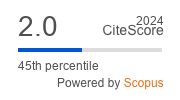Early assessment of perceived customer value: a case study comparing a low- and high-fidelity prototype in dentistry
DOI:
https://doi.org/10.23726/cij.2023.1409Keywords:
Prototyping, low-fidelity prototype, high-fidelity prototype, Design Thinking, Perceived customer valueAbstract
Perceived customer value is the measure of how customers perceive the total worth of a product or service. Providing a high perceived value is crucial for businesses to gain a competitive edge over their rivals and ensure long-term success. Prototyping has been shown to be able to measure perceived customer value and effectively collect user feedback early in the process before significant investments are made. However, the effects of prototype fidelity on assessing perceived customer value are yet to be explored. Nevertheless, the fidelity levels of a prototype should be accounted for since they significantly alter the prototype's complexity, appearance, and functionality. This paper explores such effects using a low- and a high-fidelity prototype applied to dentistry. The paper used qualitative and quantitative methods to gather feedback from dental healthcare experts and patients. Our study suggests that both low-and-high fidelity prototypes are suitable for assessing customer value. Furthermore, the fidelity levels complemented each other, improving the overall user feedback.
References
Amini, P., Falk, B., Hoth, N.C. & Schmitt, R.H., 2016. Statistical Analysis of Consumer Perceived V alue Deviation, Procedia CIRP, 51(1): pp. 1-6.
Bansal, P. & Corley, K., 2012. Publishing in AMJ-Part 7: What's Different about Qualitative Research? Academy of Management Journal, 55(3): pp. 509-513.
Berglund, A., & Grimheden, M., 2011, The importance of prototyping for education in product innovation engineering, International Conference on Research into Design Engineering, 2011, Bangalore, pp. 737-745.
Chasanidou, D., Gasparini, A.A. & Lee, E., 2015, Design Thinking Methods and Tools for Innovation, Design, User Experience, and Usability: Design Discourse, Los Angeles, pp. 12-23.
Creswell, J.W. & Poth, C.N., 2016, Qualitative Inquiry & Research Design: Choosing among Five Approaches, Sage Publications, Los Angeles, CA, USA.
Gupta, V., 2022, Technological Support for Business Model Innovation. In Innovation Mechanisms in Start-ups, Gupta, V. Springer: Berlin, Germany, pp. 71-87.
Heukelom, J., Bouvy, N. D., Alic, L., Burie, M., Graham, V., Schols, R. M., Wieringa, F. P., & Tuijthof, G. J. M., 2020, Head worn 3D-Visualization of the Invisible for Surgical Intra-Operative Augmented Reality H3D-VISIOnAiR, ATTRACT Final Conference, online, pp. 1-6.
Karimian Pour, N., 2015, Fully functional mock-ups in constructing value propositions, MSc Thesis, Tampere University of Technology, Tampere.
Kiger, M.E. & Varpio, L., 2020. Thematic analysis of qualitative data: AMEE Guide No. 131, Medical Teacher, 42(8): pp. 846-854.
Kotler, P. & Keller, K., 2012, Marketing Management, Prentice Hall, Haboken, NJ, USA.
Lyly-Yrjänäinen, J., Aarikka-Stenroos, L. & Laine, T., 2019. Mock-ups as a tool for assessing customer value early in the development process, Measuring Business Excellence, (23)1: pp. 15-23.
Menon, A., Homburg, C. & Beutin, N., 2005. Understanding customer value in business-to-business relationships, Journal of Business-to-Business Marketing, 12(2): pp. 1- 38.
Puriene, A., Aleksejuniene, J., Petrauskiene, J., Balciuniene, I., & Janulyte, V., 2007. Occupational hazards of dental profession to psychological wellbeing, Baltic Dental and Maxillofacial Journal, 9(1): pp. 72-78.
Razzouk, R. & Shute, V., 2012. What Is Design Thinking and Why Is It Important?, Review of Educational Research, 82(3): pp. 330-348.
Rudd, J., Stern, K. & Isensee, S., 1996. Low vs. High-Fidelity Prototyping Debate, Interactions, 3(1): pp. 76-85.
Smith, J. D., 2012. Single-case experimental designs: A systematic review of published research and current standards, Psychological Methods, 17(4): pp. 510-550.
Sullivan, G.M. & Artino, A.R., 2013. Analyzing and Interpreting Data From Likert-Type Scales. Journal of Graduate Medical Education, 5(4): pp. 541-542.
Woodall, T., 2012. Conceptualising ‘Value for the Customer’: An Attributional, Structural and Dispositional Analysis, Academy of Marketing Science Review, 12(12): pp. 1-42.
Downloads
Additional Files
Published
How to Cite
Issue
Section
Categories
License
Copyright (c) 2023 Karla Mariana Rojas-Martínez, Pleuntje Brons, Alexandru Dumitriu

This work is licensed under a Creative Commons Attribution 4.0 International License.
Authors who publish with this journal agree to the following terms:
- Authors retain copyright and grant the journal right of first publication with the work simultaneously licensed under a Creative Commons Attribution License that allows others to share the work with an acknowledgement of the work's authorship and initial publication in this journal.
- Authors are able to enter into separate, additional contractual arrangements for the non-exclusive distribution of the journal's published version of the work (e.g., post it to an institutional repository or publish it in a book), with an acknowledgement of its initial publication in this journal.
- Authors are permitted and encouraged to post their work online (e.g., in institutional repositories or on their website) prior to and during the submission process, as it can lead to productive exchanges, as well as earlier and greater citation of published work (See The Effect of Open Access).


